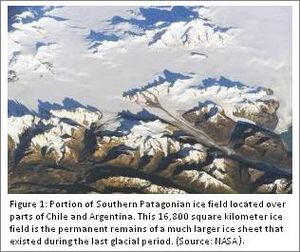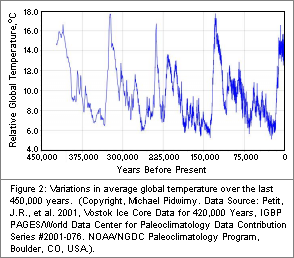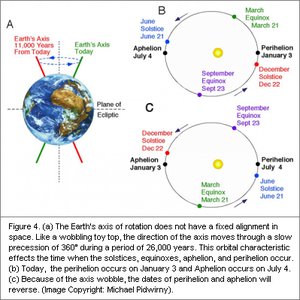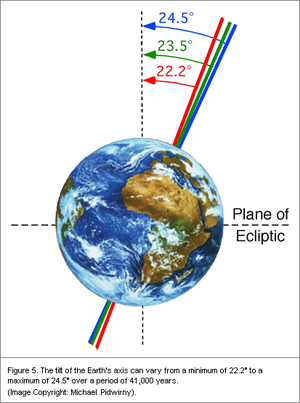Ice Age (Climate Change)
Contents
Ice Age
Introduction
Ice age refers to any of five long term events in the Earth's history. During an ice age, continental glaciers (also called ice sheets) cover extensive areas of the Northern and/or Southern Hemispheres (Figure 1).
Our planet came out of the fifth ice age, called the Pleistocene, about 12,000 years ago.
Within each ice age are numerous shorter climate flucuations called glacials and interglacials that last for many thousands of years. The five temperature peaks in Figure 2 are considered to be interglacial episodes. The periods in between the peaks would be considered glacial episodes. A glacial period (or glacial) is initiated by sustained surface temperature cooling causing the formation and growth of glaciers and ice sheets at high altitudes and high latitudes.
An interglacial period (or interglacial) is an interval of warmer surface temperatures that causes the melting and retreat of glaciers and ice sheets. The current interglacial, known as the Holocene, has persisted for about 12,000 years.
Evidence for Past Ice Ages
Scientists have been able to determine the occurence of ice ages in the past based on the following types of evidence:
Geological - Large sheets of ice covering our planet's surface leave behind tell-tale features on the landscape. The features associated with these glacial landforms are produced by the geomorphological processes of erosion and deposition.
Chemical - Glacial events can leave behind specific types of chemical evidence in the environment. The most widely studied type of evidence for past climate change are variations in chemical isotopes found in fossils and sedimentary deposits. For example, the ratios of different isotopes for a particular chemical can be used to determine past climatic conditions.
Biological - Variations in climate can be determined by the analysis of biological data like annual tree rings, fossilized pollen and other plant macrofossils, the abundance and distribution of insects and other organisms, and the biota in lake and ocean sediments.
Formation of Ice Ages
Scientific understanding of the fundamental triggers for the start and end of ice ages is far from complete. Generally, an ice age commences after a prolonged global cooling. Some of the mechanisms that have been suggested include: (a) long-term cyclical changes in the Earth's orbital characteristics (the Milankovitch Cycles); (b) changes in the chemical composition of the atmosphere; (c) plate tectonic movements and the change in the positon of the Earth's continents and ocean currents; and (d) a complex feedback process where the presence of extensive ice-free oceans leads to increased evaporation and precipitation, which then causes an increase in high latitude snowfalls and eventually the growth of glaciers and ice sheets. This sequence is reinforced by the negative feedback process of increasing albedo and further declines in surface temperatures.[1]
Milankovitch Cycles
In the 1930s, Serbian astronomer Milutin Milankovitch mathematically investigated the influence that three orbital characteristics had on the Earth. From his calculations, Milankovitch theorized that these astronomical cycles would cause signification variations in the amount of sunlight received by the Earth’s surface. Other scientists examined the relationship between the Milankovitch cycles and long-term climate change. The results of this research suggests that these cycles may be responsible for the advance and retreat of continental glaciers during the Pleistocene.
The first cyclical variation, known as eccentricity, controls the shape of the Earth's orbit around the Sun (Figure 3). During this cycle, the Earth’s orbit gradually changes from being elliptical, to being nearly circular, and back to elliptical in a period of about 100,000 years. The greater the eccentricity of the orbit (the more elliptical it is), the greater the variation in solar energy received at the top of the atmosphere between the Earth's closest (perihelion) and farthest (aphelion) approach to the Sun. Currently, the Earth is experiencing a period of low eccentricity. The difference in the Earth's distance from the Sun between perihelion and aphelion (which is only about 3%) is responsible for approximately a 7% variation in the amount of solar energy received at the top of the atmosphere. When the difference in this distance is at its maximum (9%), the difference in solar energy received is about 30%.
The second cyclical variation results from the fact that as the Earth rotates on its polar axis, it wobbles like a spinning top changing the orbital timing of the equinoxes and solstices. This effect is known as the precession of the equinox. The precession of the equinox has a cycle of approximately 26,000 years. According to Figure 4, the Earth is closer to the Sun in January (perihelion) and farther away in July (aphelion) at the present time. Because of precession, the reverse will be true in 13,000 years and the Earth will then be closer to the Sun in July. This means, of course, that if everything else remains constant, 13,000 years from now seasonal variations in the Northern Hemisphere should be greater than at present (colder winters and warmer summers) because of the closer proximity of the Earth to the Sun.
The third cyclical variation is related to the changes in the tilt (obliquity) of the Earth's axis of rotation over a period of 41,000 years. During this cycle, the tilt of the axis can deviate from approximately 22.2 to 24.5° (Figure 5). Today, the tilt of the Earth's axis is 23.5°.
When the tilt is small there is less climatic variation between the summer and winter seasons in the middle and high latitudes. Winters tend to be milder and summers cooler. Warmer winters allow for more snow to fall in the high latitude regions. When the atmosphere is warmer it has a greater ability to hold water vapor and therefore more snow is produced at areas of frontal or orographic uplift. Cooler summers cause snow and ice to accumulate on the Earth's surface because less of this frozen water is melted. Thus, the net effect of a smaller tilt would be more extensive formation of glaciers in the polar latitudes.
Periods of a larger tilt result in greater seasonal climatic variation in the middle and high latitudes. At these times, winters tend to be colder and summers warmer. Colder winters produce less snow because of lower atmospheric temperatures. As a result, less snow and ice accumulates on the ground surface. Moreover, the warmer summers produced by the larger tilt provide additional energy to melt and evaporate the snow that fell and accumulated during the winter months. In conclusion, glaciers in the polar-regions should be generally receding, with other contributing factors constant, during this part of the obliquity cycle.
Computer models and historical evidence suggest that the Milankovitch cycles exert their greatest cooling and warming influence when the troughs and peaks of all three cycles coincide with each other.
Researchers of the 1970s CLIMAP project found strong evidence in deep-ocean sediments of variations in the Earth's global temperature during the past several hundred thousand years of the Earth's history. Other subsequent studies have confirmed these findings and have discovered that these temperature variations were closely correlated to the concentration of carbon dioxide in the atmosphere and variations in solar radiation received by the planet as controlled by the Milankovitch cycles. Measurements indicated that atmospheric carbon dioxide levels were about 30% lower during colder glacial periods. It was also theorized that the oceans were a major store of carbon dioxide and that they controlled the movement of this gas to and from the atmosphere. The amount of carbon dioxide that can be held in oceans is a function of temperature. Carbon dioxide is released from the oceans when global temperatures become warmer and diffuses into the ocean when temperatures are cooler. Initial changes in global temperature were triggered by changes in received solar radiation by the Earth through the Milankovitch cycles. The increase in carbon dioxide then amplified the global warming by enhancing the greenhouse effect.
Changes in the Chemical Composition of the Atmosphere
There is evidence to suggest that during the Pleistocene Ice Age that the levels of carbon dioxide and methane in the atmosphere changed with the glacier growth and retreat. As mentioned in the previous sectiopn, carbon dioxide concentrations drop on average by about 30% from an interglacial to a glacial period. Why this occurs is also explained above.
Most of the methane found in our planet's atmosphere originates from emissions produced in wetlands from decaying plant biomass in anerobic environments. Scientists have discovered that the concentration of atmospheric methane drops by about 40% from an interglacial to glacial period. Driving this decline is a reduction in environments where wetlands can occur. Because of its greenhouse properties increasing Earth temperatures produce a positive feedback system, while cooling temperatures create a negative feedback effect. Initiating the whole process, like the changes in atmospheric carbon dioxide, are the Milankovitch cycles.[2]
Volcanic eruptions contribute significant amounts of particulate matter and gases to the atmosphere (Atmosphere layers), the fine fraction of which remains resident in the air for long periods of time. This simple effect reduces solar insolation at the Earth's surface and thus promotes global cooling. At a more complex level, volcanic-tectonic interactions cause the movement of entire continents and affect global ocean circulation, which factors can be very significant in major turning points for climate change.[3]
Plate Tectonics and Continental Plate Positioning
The positions of major landmasses influence climate in three major ways viewed over the geologic time frame. First the location of large landmasses near the poles facilitate the formation of large permanent ice sheets, as in the case of present Antarctica. Secondly the presence of appreciable landmasses near the equator can alter the integrated Earth's albedo, since land has a decidedly different reflectance from ocean expanse. Thirdly, the continental land masses are influential in driving ocean currents in north-south currents, deviating from the natural prevailing ocean circulation that would exist in the absence of continents. An extreme example of continental positioning occurred about three million years before present, when the Isthmus of Panama closed, dramatically altering east-west ocean currents.
High Latitude Evaporation
In the situation where circumpolar seas are ice-free, the albedo is reduced and evaporation increases, hence raising high latitude snowfall. Over the progression of considerable time, this sequence is thought to be able to lead to ever thickening snow pack and eventual buildup of ice sheets. This is actually a natural correction and negative feedback loop for geologic time global warming.
Principal Ice Ages
Researchers have identified at least five major ice ages during the 4.6 billion years of Earth history. In between these events, the Earth was generally ice free even at high latitudes. The earliest ice age is the Huronian, which began approximately 2.4 to 2.2 billion years before present. Geological evidence for this event (began in the early Proterozoic) in the form of till and outwash deposits, varves and ice scoured rock surfaces can be found north of Lake Huron.[4]
The second major ice age occurred between 850 to 600 million years before present (Cryogenian Period) and is believed to be the most severe in the history of the Earth. This ice age saw glaciation extend to the equatorial region of the Earth. The trigger for this cataclysmic freeze, often called Snowball Earth, may have been re-alignment of major continental land masses at the poles.[5] The end of this period coincides with the appearance of higher life forms, led by an explosion in the number of multi-cellular invertebrate lifeforms.
The third ice age known as the Andean-Saharan, occurred between 460 to 430 million years before present.[6] Evidence for this glacial event comes from Arabian Peninsula, central Sahara, western Africa, the lower Amazon of Brazil, and the Andes of western South America.
The next clearly defined ice age occurred between 360 to 260 million years before present. This event is termed the Karoo Ice Age, because the first evidence of its occurrence was found in the Karoo region of South Africa.[7] Researchers believe this ice age was caused by an increase in oxygen levels and subsequent decline in carbon dioxide in the atmosphere prior to this event. These changes in the atmosphere were the result of increasing dominance of land plants which locked up the carbon in their biomass. With less carbon dioxide in the atmosphere, the heat added to the atmosphere by the greenhouse effect dropped, cooling the Earth's global temperature.
The current ice age is generally believed to have started in the late Pliocene approximately 2.58 million years before present. However, the formation and subsequent growth of an extensive ice sheet over Antarctica seems to have started about 20 million years ago. During the Pleistocene Ice Age, our planet underwent numerous glacial and interglacial sequences, driven by cyclical changes in the Earth's orbital characteristics. At the present time we are in an interglacial period, the warming trigger of which began well before the impact of man upon the planet. Present testimony to the current Ice age is defined by the extensive ice sheets covering most of Antarctica and Greenland, as well as significant ice fields in the Andes Mountains in Argentina and Chile, as well as the Darwin ice sheet in covering much of Tierra del Fuego and significant glaciated areas in North America, Norway, New Zealand and other world regions.
Ecological effects
Ice ages had a profound influence on the Earth's ecosystems, including the erosion and deposition of vast landscapes, presenting species with challenging climatological conditions, and the isolation of genetic sub-populations. Not only have the weathering effects produced entire new landforms of till, moraine, drumlins and other specialized surface rock features, but they have created major lacustrine features such as the Great Lakes and expansive limestone pavements such as the Burren in Ireland and the island of Oland in Sweden.
The austere climate conditions have required species to adapt to harsh environments or perish. Massive glaciers have fragmented previously continuous habitats and presented opportunities for speciation in more isolated locales. These conditions have created entire realms of surviving biota that are sometimes termed refugia. Examples of refugia can be found in the southwestern mountains of the USA and the Gilgit-Indus Basin of Pakistan.[8]
References
Citation
Pidwirny, M., & Hogan, C. (2012). Ice Age. Retrieved from http://editors.eol.org/eoearth/wiki/Ice_Age_(Climate_Change)- ↑ Ruddiman, William F. 2008. Earth's Climate: Past and Future. Second Edition. W.H. Freeman and Company, New York.
- ↑ Clark, Peter U., Arthur S.Dyke, Jeremy D.Shakun, Anders E.Carlson, Jorie Clark, Barbara Wohlfarth, Jerry X.Mitrovica, Steven W.Hostetler et al. 2009. "The last glacial maximum". Science 325 (5941) 710-714
- ↑ Marti, Joan and Gerald Ernst (Editors). 2008. Volcanoes and the Environment. Cambridge University Press, Cambridge, UK.
- ↑ Hore, Reginald E. 1910. "On the Glacial Origin of Huronian Rocks of Nipissing, Ontario". Journal of Geology 18, No. 5: 459-467.
- ↑ Rohli, Robert V. and Anthony J. Vega. 2008. Climatology. Jones and Barttlett Publishers, Sudbury, MA, USA.
- ↑ U.S.National Research Council. 1982. Climate in Earth History. NRC Geophysics Study Committee, American Geophysical Union Meeting.
- ↑ Frederick, John E. 2008. Principles of Atmospheric Science. Jones and Barttlett Publishers, Sudbury, MA, USA.
- ↑ Komer, Christian and Eva M. Spehn (Editors). 2002. Mountain Biodiversity: A Global Assessment. CRC Press.





